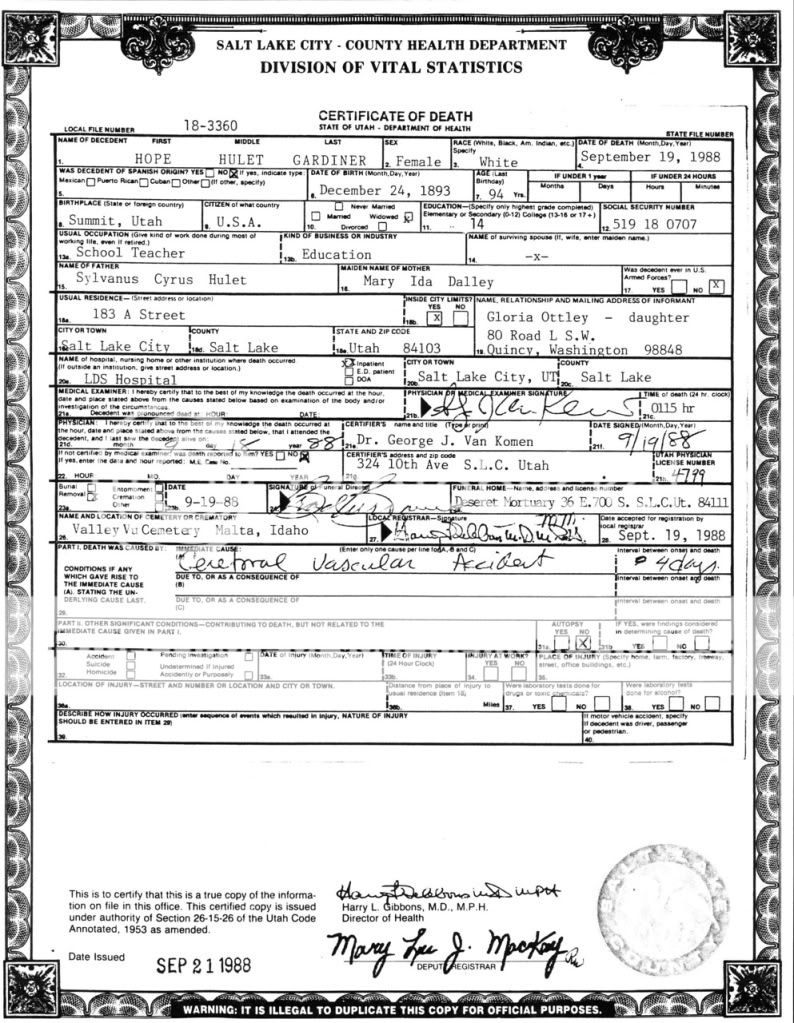
James Gardiner: Hope Hulet Gardiner was bom 24 December 1893 in Summit, Iron County, Utah. She was the sixth child born to Sylvanus Cyrus and Mary Ida Dalley Hulet. She enjoyed her childhood in Summit where everyone was related and lived as one" big family." She completed her first 7 years of schooling here. In 1908 the family moved to Peterson, Morgan County, Utah. She graduated from the eighth grade at Peterson and had the honor of being valedictorian of the Morgan County Schools.
She attended her first year of high school at the Ogden High School. In 1912 she went to Logan and attended the Utah State Agricultural College. She was offered a job of teaching at Peterson. She taught there three years. In 1918 she took a position teaching the first grade at Declo, Idaho, where she had 55 pupils. In 1919 she taught summer school at Meadow Creek, Idaho.
While living at Meadow Creek, she met Frederick Gardiner, who raised sheep in that area. They were married 2 June 1920 in the Salt Lake temple.
They moved to Peterson, Utah in 1922, where Fred worked on the railroad. In the spring of 1925 they again went to Idaho, where they took up a desert claim at Bridge. They moved to a place near Malta that fall, then in July 1929, they bought the farm nearer Malta which has been their home since.
They raised 7 children. One son, Robert, died in infancy. The children were all good students and received good educations.
In 1944 Hope was appointed a.school trustee. In 1946 teachers were scarce, so she was released from her school trustee position and began teaching school again. She taught one year in Malta, one year in Burley, then again in Malta for ten years. She taught first grade or first and second combined. Teaching is something she enjoyed very much.
She has taught Sunday School, served on the Stake boards of the Relief Society and Primary, and been a counselor in the Stake MIA. She has spent considerable time working in genealogy, which she has found to be very satisfying.
Fred passed away 26 December I960. He was also active in the church. He served in the High Priest Quorum, as High Counselor, Ward Clerk, and a teacher. Kent Gardiner: Hope Hulet was born in Summit, Utah, in 1893, the sixth child of Sylvanus Cyrus Hulet, Jr. and Mary Ida Dalley Hulet. Hope came from a close-knit family. Hope grew up in Summit, UT which is a very small town in southern Utah. In her teenage years the family moved to Peterson, UT.
She became a schoolteacher in Meadow Creek, Idaho where she met Fred and married him in the Salt Lake Temple. One day while doing the laundry she discovered Bull Durum cigarettes in Fred’s shirt. When he came home she said, “Fred either the cigarettes go or I go.” He made the right choice. In spite of living below the poverty line she was never heard to utter a word of complaint, worked hard and raised a fine family including: JH, Golden, Mary, Dawn, Margaret, Gloria, Robert and Frank.
In her later years she worked on family history and was an avid journalist and genealogist. Hope was an inspiration to her family for her long suffering, strength of character, kindness and gentle nature. She lived to be 94 and is buried in the Malta Valley Vu Cemetery.
Albion Normal School
Barbara Ehlers Gardiner daughter-in-law
Charles Hulet - Pioneer
Charles Hulet and His Wives (full history)
Dawn James, daughter
Dean Ottley, son in law
Dustin Ray Hulet
Edna Hulet (Jones), sister
Eleanor, Hope's sister
Elzine Robena Hulet
Father Hulet in Vegas
Hope Hulet, Full History importantBarbara Ehlers Gardiner daughter-in-law
Charles Hulet - Pioneer
Charles Hulet and His Wives (full history)
Dawn James, daughter
Dean Ottley, son in law
Dustin Ray Hulet
Edna Hulet (Jones), sister
Eleanor, Hope's sister
Elzine Robena Hulet
Father Hulet in Vegas
Hope's letters to the James Gardiner family
Hope Short History
Hulet Newsletter 1962
Hulet Research
Isaac Jones, the man who confirmed Hope
James Hulet Gardiner, son
John R. Hulet
Katherine Hulet (Winget)
Katherine Melissa Hulet
Malta Flooding
Mary Gardiner, daughter
Margaret, daughter
Minnie Elzina Hulet
Nephi James Hulet, brother
Hulet Research
Isaac Jones, the man who confirmed Hope
James Hulet Gardiner, son
John R. Hulet
Katherine Hulet (Winget)
Katherine Melissa Hulet
Malta Flooding
Mary Gardiner, daughter
Margaret, daughter
Minnie Elzina Hulet
Nephi James Hulet, brother
Nephi Hulet's photos
Robert Hulet Gardiner, son
Rhoda Hulet
Schuyler Hulett
Sylvester Hulet Pioneer
Sylvester Hulet in the Deseret News
Sylvester Silas Hulet
Thora Hulet, sister
Thora Hulet Wood Johnson
Warren Schuyler Hulet
Robert Hulet Gardiner, son
Rhoda Hulet
Schuyler Hulett
Sylvester Hulet Pioneer
Sylvester Hulet in the Deseret News
Sylvester Silas Hulet
Thora Hulet, sister
Thora Hulet Wood Johnson
Warren Schuyler Hulet
The summer after we married Suzanne and I drove to Idaho
where I introduced my wife to Hope Hulet Gardiner, She let us sleep
in her own bed and made all the meals. I think she knew how fond I
was of her. I enjoyed sitting in the kitchen while she cooked,
feeling the oven warmth and listening to the sweet tones of her voice.
She hated having her picture taken but I insisted that she come
outside so I could take her picture against the Malta sky. She was an
amazing woman in many respects. Even though her husband lost all his
wealth the year after they were married she calmly and sweetly loved
him, with never a word of complaint. She taught school, raised a fine
family, cooked delicious chicken and turkeys that she raised herself.
She even kept a garden and lived in a home without an inside toilet.
Yes it was out to the outhouse for twenty years. She was one amazing
woman. I am proud to be her grandson. Kent
Hope from K on Vimeo.
1900 Federal census:
Note: Lettie had 8 children, lived in Wyoming and her children kept the faith by marrying in the temple. Kent
Hope Hulet (Gardiner's) home growing up in Summit, UT
Education:
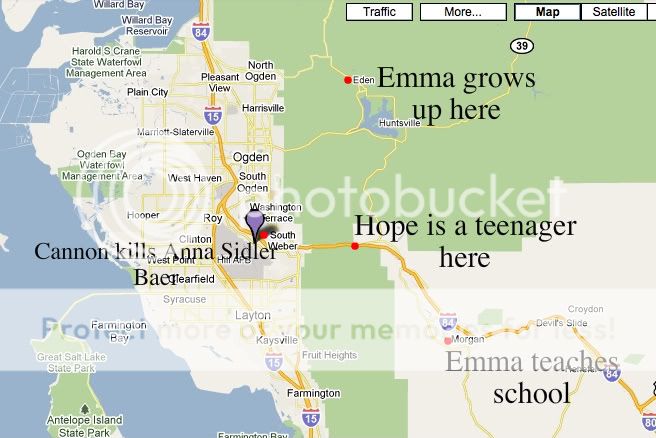
September 14, 1908, Salt Lake Republican:
September 6, 1917, Salt Lake Telegram:
September 7, 1917, Ogden Standard:
Hope's receipe:
Tributes to Hope:
2010 Hope from K on Vimeo.
2010 SAG on Hope from Deborah Gardiner on Vimeo.
Special video presentation below: The Secret Cave below!


Hope and her class 1948-1949.
1940 census:
May 2, 1935 Morgan County News:
Malta home: (without the 1970's addition)
Visiting Malta each summer was great for us. Here are some of us getting eggs from the hen house. KG
1984 Malta Flood
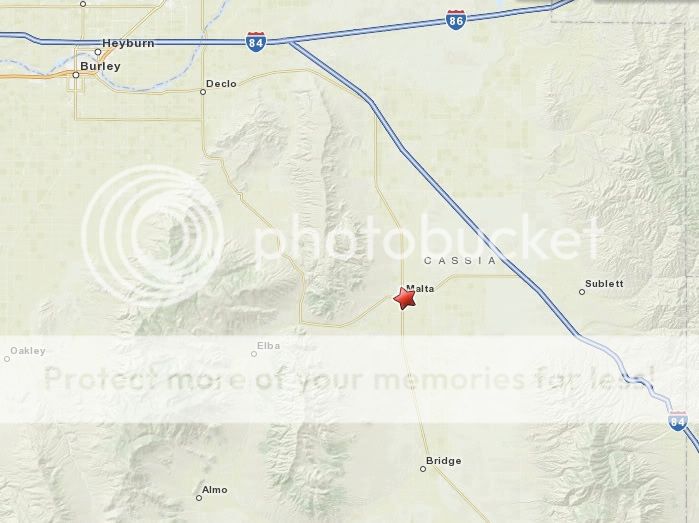
Untitled from K on Vimeo.
Carol on Hope:
Carol on Turkeys and Dresses from K on Vimeo.

Hope had a son who died as an infant, named after Frederick's father:
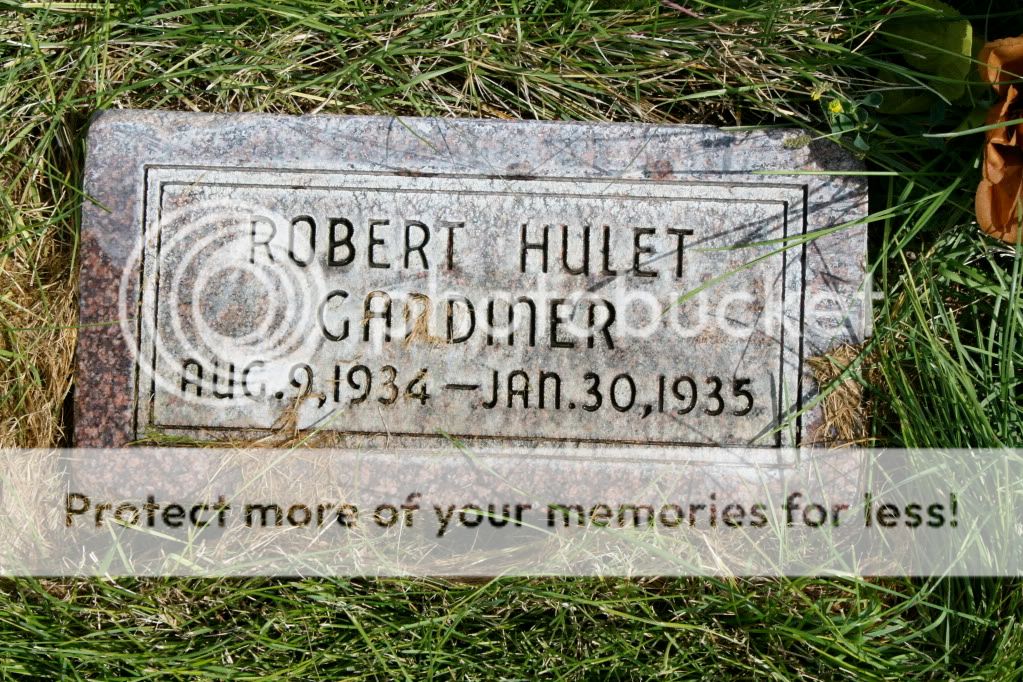

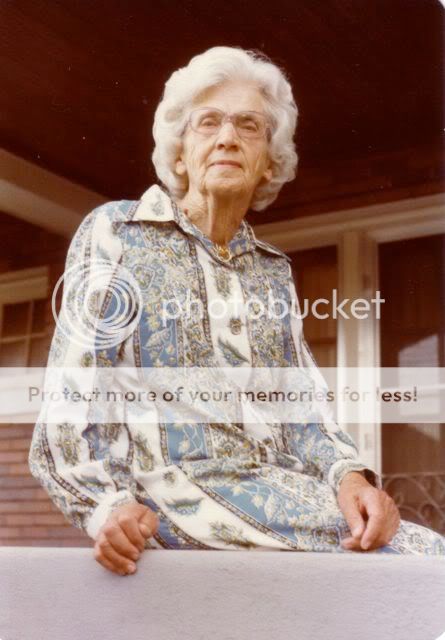
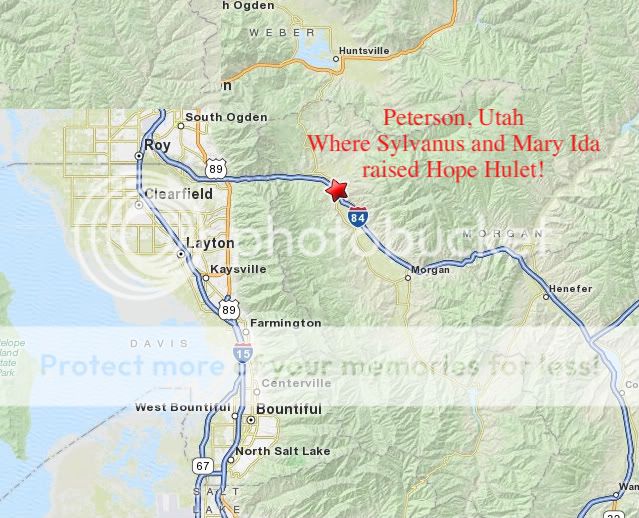
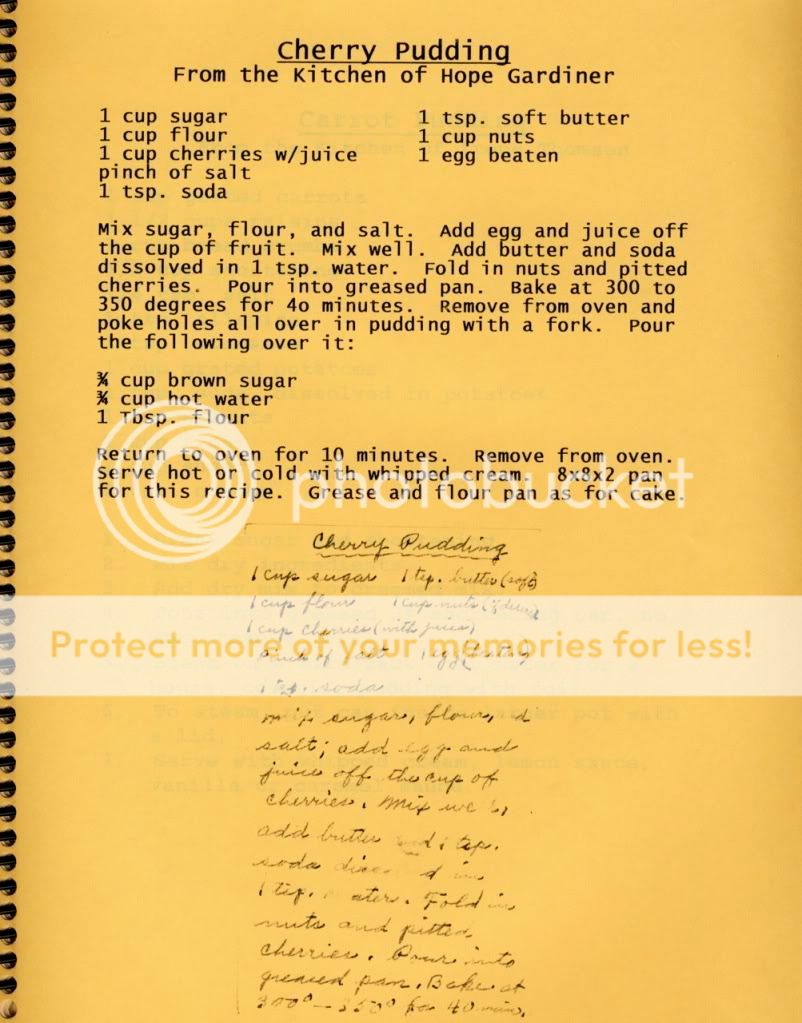
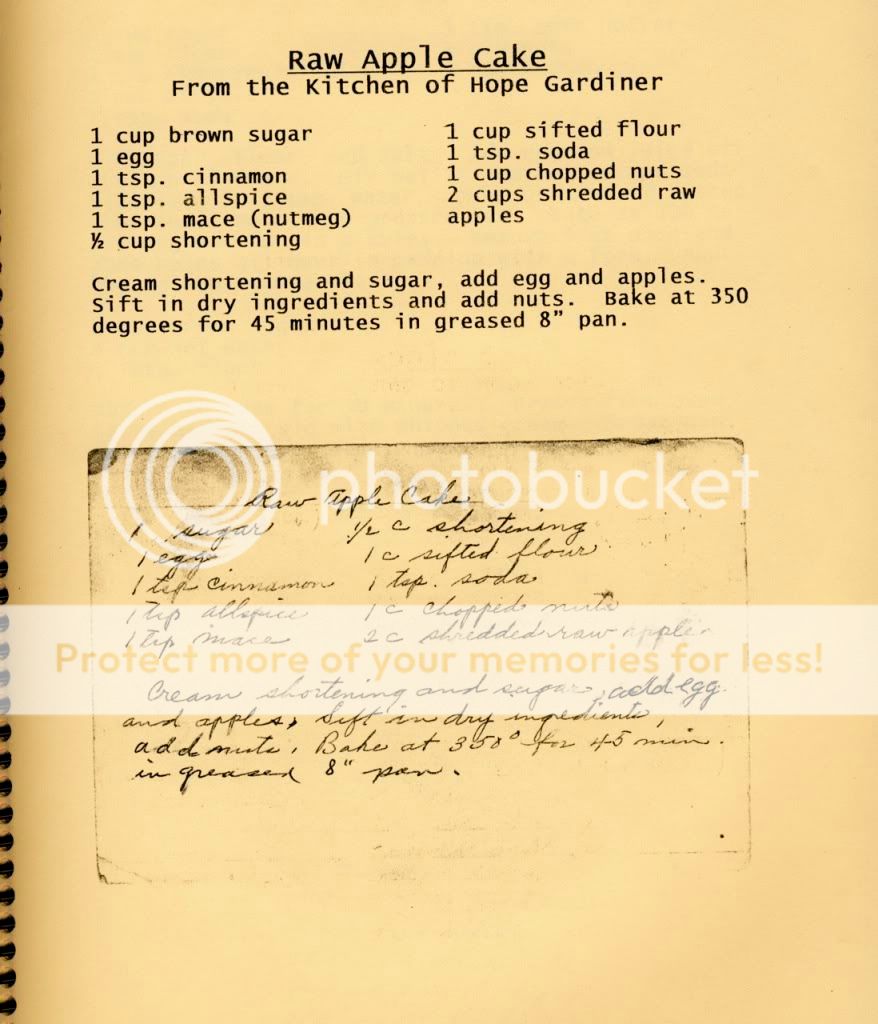
1975:
The summer after we married, Suzanne and I headed out for Idaho where we spent some time with Hope Hulet Gardiner, (my grandmother your great grandmother). She let us sleep in her own bed and made all the meals. I think she knew how fond I was of her. I enjoyed sitting in the warm kitchen while she cooked, feeling the oven warmth and listening to the sweet tones of her voice.
She hated having her picture taken but I insisted that she come outside so I could take her picture against the Malta sky. She was an amazing woman in many respects. Even though her husband lost all his wealth the year after they were married she calmly and sweetly loved him, with never a word of complaint. She taught school, raised a fine family, cooked delicious chicken and turkeys that she raised herself. She even kept a garden and lived in a home without an inside toilet. Yes it was out to the outhouse for twenty years. She was one amazing woman. I am proud to be her grandson. Kent
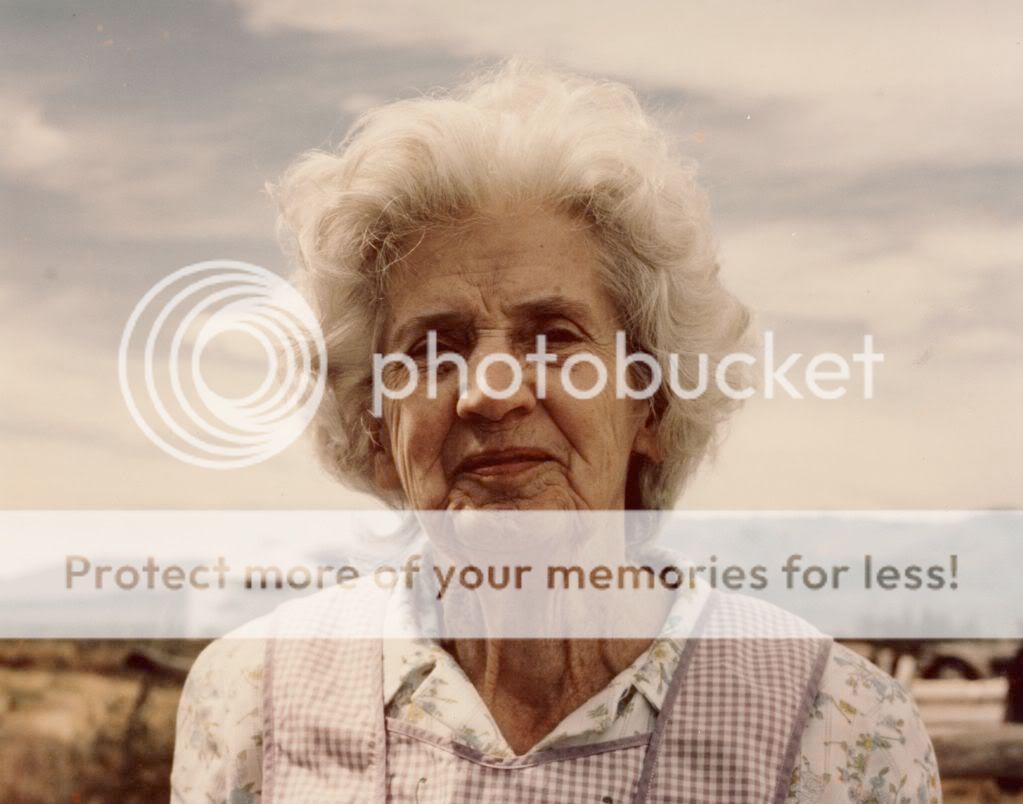
Kent,
Thank you for the beautiful picture. It captured Grandma's beauty -- both her inner and outer beauty. Whenever I hear the phrase Latter-day Saint I always think of Grandma. She has always been the benchmark I use when I hear the word "saint" -- she comes as close as anyone I've ever known to epitomizing that word.
We were blessed to live close by and she spent many hours with us as children when our mother was away. When I was a very small boy Grandma was cooking boiled eggs at our home and I reached up and pulled the boiling water down on my arm. My arm was severely burned and my parents tell me that my arm was miraculously healed through Grandma's pleadings to the Lord. I don't have any sort of scarring to this day from that accident.
I love to hunt and fish and mother always told me when I caught enough fish or bagged enough pheasants that she would be happy to cook it for the whole family. Well I was never succesful at getting enough to feed the whole family so I would often take it to Grandma. She could make any and everything taste so good. I would always clean and dress the animals and she would cook it -- she wouldn't waste anything. I remember M... telling me how a pheasant hunter had shot a pheasant near Grandma's backyard. They told him to leave and M... or G... retreived the bird. Grandma knew just what to do with it and always cooked them to perfection. Even when Grandma was in her nineties and her eyesight was almost gone she could still cook.
Thanks for sharing your note and picture with me. Seeing Grandma gives rise to many sweet emotions and has a way of making me want to be a better person so that I can be where she is someday. C
Letter from Hope to the James Gardiner family:
1974 June 1, “The Beautiful Way"
The book you wanted – “The Beautiful Way” would likely be helpful. If I can’t get a chance to get it bound before you come you may have to take it as is. I did want to have it rebound for you. I always thought a lot of it. Mother (Mary Ida Dalley) gave it to me when I was about 10 years old because she said I was the only one who seemed to want to read it. It has so much good material in it that should be given out to many people.
Link to book: https://archive.org/stream/beautifulwayofli00pete#page/n1/mode/2up
1988 JHG Funeral Talk on Hope Hulet from K on Vimeo.
Research:
Hi everyone, Does anyone know why Isaac Jones rather than some other family member confirmed Hope Hulet? (Maybe its in Hope's history, but I haven't read it all yet. By the way, its a great history! I really enjoy reading it.) I have tried to find out if Isaac was in the bishopric or something like that, but have been unsuccessful. I now know that he was an uncle to Hope and that he had a daughter about Hope's age and that the two girls were great friends. I also know that he had returned from an LDS mission about a year before confirming Hope. Other than that I don't know why Isaac was chosen rather than Hope's father or grandfather. If you know, please let me know. Thanks, N
where I introduced my wife to Hope Hulet Gardiner, She let us sleep
in her own bed and made all the meals. I think she knew how fond I
was of her. I enjoyed sitting in the kitchen while she cooked,
feeling the oven warmth and listening to the sweet tones of her voice.
She hated having her picture taken but I insisted that she come
outside so I could take her picture against the Malta sky. She was an
amazing woman in many respects. Even though her husband lost all his
wealth the year after they were married she calmly and sweetly loved
him, with never a word of complaint. She taught school, raised a fine
family, cooked delicious chicken and turkeys that she raised herself.
She even kept a garden and lived in a home without an inside toilet.
Yes it was out to the outhouse for twenty years. She was one amazing
woman. I am proud to be her grandson. Kent
Hope from K on Vimeo.
1900 Federal census:
From Hope's history: (see the name two above this line)
Cousin Lettie Jones and I were together most of the time. I was either at her home or she was at my home. She was a year older than I was. Her birthday was December 26, mine was December 24. About 1901 when she was about ten years, old her parents, Uncle Isaac Jones and Aunt Lena (Mother’s sister), moved to Otto, Bighorn County, Wyoming. How I did miss her. We had been so very close to each other all our lives up to this time. We have never seen each other since she moved away from Summit. Lettie and I corresponded until I was about 17 years old. She got married about that time and quit writing. She raised a fine family.
Baptism
Since my birthday is December 24, the weather at that time of year is usually cold. When I was eight years old I wanted to be baptized, but Father wasn’t home on my birthday. However, on 29 December 1901, even though the creek in front of our home was frozen over, Father managed to let me get baptized. He heated two big brass kettles of water to about the boiling point then poured the hot water into a large, scrubbed out tank of creek water. It was still plenty cold, but not too bad. Father baptized me, and they hurried me into the house to get dry clothes. Uncle Isaac Jones confirmed me that day in the kitchen of our home. Cousin Lettie was with me that day.
Since my birthday is December 24, the weather at that time of year is usually cold. When I was eight years old I wanted to be baptized, but Father wasn’t home on my birthday. However, on 29 December 1901, even though the creek in front of our home was frozen over, Father managed to let me get baptized. He heated two big brass kettles of water to about the boiling point then poured the hot water into a large, scrubbed out tank of creek water. It was still plenty cold, but not too bad. Father baptized me, and they hurried me into the house to get dry clothes. Uncle Isaac Jones confirmed me that day in the kitchen of our home. Cousin Lettie was with me that day.
Note: Lettie had 8 children, lived in Wyoming and her children kept the faith by marrying in the temple. Kent
Hope Hulet (Gardiner's) home growing up in Summit, UT
Hope attended school in Summit through the seventh grade. In 1908 at age 14 she attended eighth grade in Peterson where she was the valedictorian. For the school year 1909-1910 she attended Ogden high school, which was not available in Petersen. For the next two years she didn’t attend school due to family financial and other problems. In the fall of 1912 she began attending Utah State Agricultural College and completed her high school requirements in the spring of 1915 (three years) then attended summer school to get her teacher’s certificate. She taught school in Peterson for 3 years with a beginning salary of $50 per month with a $5 raise each year. In the fall of 1915 she went to summer school in Albion , Idaho and taught school in Declo , Idaho Meadow Creek , Idaho
Letter from Hope to her son JHG on Gypsies:
To most residents of rural Utah in the early 1900's summertime meant hauling hay, digging ditches, irrigating crops, and tending livestock. Other than the usual dances and town parties there was little diversion from the monotony of farm labor--that is until traveling bands of Gypsies began making appearances and causing stirs of excitement. In Deseret, Elsinore, Oak City, Kanab, and other remote communities news of these exotic visitors would spread quickly. Most of the Gypsies were of Balkan, Eastern, and Central European descent and had come to America at the turn of the century. Their nomadic lifestyle took them from ranch house to farm village where they would entertain, beg, and reportedly even steal to survive.
The men in their big hats and spangled vests and the women in full skirts, black braided hair, bright scarves, necklaces made of coins, and large earrings would lead their caravan of wagons, horses, dogs, and children through town. They often entertained the townsfolk with trained animals. In Manti, Sanpete County, one resident remembered a band of Gypsies that owned a large black bear that danced; this group also had a monkey, perched atop an organ grinder, that caught all the nickels thrown to him. In Oak City, Millard County, a Gypsy singer entertained town residents for hours at the city hall with his extensive repertoire. In Elsinore, Sevier County, another Gypsy performed rope tricks; an hour-long demonstration of his skill was a highlight of the town's Fourth of July celebration.
In addition to showcasing their various talents, the Gypsies employed other methods to earn a living. Gypsy women would often tell fortunes for fifty cents, many of the men were ardent horse traders, and there are also stories of persistent Gypsy begging. Burt Hales told of the family garden in Oak City from which his father peddled produce to help support the family. One day after his father had given the Gypsies some vegetables, one lady was not satisfied and returned to get more. Hales's explained that he had given all he could and needed the rest for his customers. When the woman persisted and started into the garden, Hales's father had to call the family dog to induce her to leave.
The Gypsies generally traveled in groups of five to ten families and camped in vacant lots on the outskirts of town. They would stay a few weeks to a month before moving on to other communities. In the end, industrialization, the coming of the automobile, and the Great Depression all combined to bring an end to the Gypsies' way of life. In order to obtain government relief many were forced into a sedentary urban lifestyle, and their nomadic wanderings largely vanished. Regardless, memories of the entertainment and adventure that the Gypsies seemed to create linger among older residents of several rural Utah communities.
Letter from Hope to her son JHG on Gypsies:
1966 August 23, Gypsies
I feel like a gypsy every time I think of letting you folks pay for all those groceries that I got. I thought that while I was there I would get some extra supplies on hand because I don’t get a chance to go to Burley very often.
Had I thought your father (JH) would insist on paying the bill I would not have gotten nearly so much at that time? I felt like I was in the same class as some gypsies that came to our home in Summit.
Father and mother had a nice garden. The gypsies wanted some vegetables. Mother had a baby in her arms so told the woman to go in and get some for themselves. She went in and here came some more gypsy women. They had large aprons that tied around their waists. They loaded themselves down the cabbages, lettuce, potatoes etc. until they could hardly walk and still kept grabbing for more.
Mother finally had to threaten to send for the police. She sent for her father who came and made the gypsies leave.
So if your father doesn’t want his mother to be in the gypsy class he better take this $20 and not feel hurt.
Notes:
To most residents of rural Utah in the early 1900's summertime meant hauling hay, digging ditches, irrigating crops, and tending livestock. Other than the usual dances and town parties there was little diversion from the monotony of farm labor--that is until traveling bands of Gypsies began making appearances and causing stirs of excitement. In Deseret, Elsinore, Oak City, Kanab, and other remote communities news of these exotic visitors would spread quickly. Most of the Gypsies were of Balkan, Eastern, and Central European descent and had come to America at the turn of the century. Their nomadic lifestyle took them from ranch house to farm village where they would entertain, beg, and reportedly even steal to survive.
The men in their big hats and spangled vests and the women in full skirts, black braided hair, bright scarves, necklaces made of coins, and large earrings would lead their caravan of wagons, horses, dogs, and children through town. They often entertained the townsfolk with trained animals. In Manti, Sanpete County, one resident remembered a band of Gypsies that owned a large black bear that danced; this group also had a monkey, perched atop an organ grinder, that caught all the nickels thrown to him. In Oak City, Millard County, a Gypsy singer entertained town residents for hours at the city hall with his extensive repertoire. In Elsinore, Sevier County, another Gypsy performed rope tricks; an hour-long demonstration of his skill was a highlight of the town's Fourth of July celebration.
In addition to showcasing their various talents, the Gypsies employed other methods to earn a living. Gypsy women would often tell fortunes for fifty cents, many of the men were ardent horse traders, and there are also stories of persistent Gypsy begging. Burt Hales told of the family garden in Oak City from which his father peddled produce to help support the family. One day after his father had given the Gypsies some vegetables, one lady was not satisfied and returned to get more. Hales's explained that he had given all he could and needed the rest for his customers. When the woman persisted and started into the garden, Hales's father had to call the family dog to induce her to leave.
The Gypsies generally traveled in groups of five to ten families and camped in vacant lots on the outskirts of town. They would stay a few weeks to a month before moving on to other communities. In the end, industrialization, the coming of the automobile, and the Great Depression all combined to bring an end to the Gypsies' way of life. In order to obtain government relief many were forced into a sedentary urban lifestyle, and their nomadic wanderings largely vanished. Regardless, memories of the entertainment and adventure that the Gypsies seemed to create linger among older residents of several rural Utah communities.
For additional information see David A. Hales, "'The Gypsies Are Coming! The Gypsies Are Coming!,'" Utah Historical Quarterly 53 (fall 1985): 367-79.

September 14, 1908, Salt Lake Republican:
September 7, 1917, Ogden Standard:
1944 Relief Society:
Hope's receipe:
Tributes to Hope:
2010 SAG on Hope from Deborah Gardiner on Vimeo.
Special video presentation below: The Secret Cave below!


Hope and her class 1948-1949.
1940 census:
May 2, 1935 Morgan County News:
1934 Gardiner women plus Elaine on the far right, Hope third from left:
November 28, 1947, Morgan County News:
June 10, 1949, Morgan County News:
Malta home: (without the 1970's addition)
Visiting Malta each summer was great for us. Here are some of us getting eggs from the hen house. KG
1984 Malta Flood

Untitled from K on Vimeo.
Carol on Hope:
Carol on Turkeys and Dresses from K on Vimeo.

Hope had a son who died as an infant, named after Frederick's father:






1975:
The summer after we married, Suzanne and I headed out for Idaho where we spent some time with Hope Hulet Gardiner, (my grandmother your great grandmother). She let us sleep in her own bed and made all the meals. I think she knew how fond I was of her. I enjoyed sitting in the warm kitchen while she cooked, feeling the oven warmth and listening to the sweet tones of her voice.
She hated having her picture taken but I insisted that she come outside so I could take her picture against the Malta sky. She was an amazing woman in many respects. Even though her husband lost all his wealth the year after they were married she calmly and sweetly loved him, with never a word of complaint. She taught school, raised a fine family, cooked delicious chicken and turkeys that she raised herself. She even kept a garden and lived in a home without an inside toilet. Yes it was out to the outhouse for twenty years. She was one amazing woman. I am proud to be her grandson. Kent

Kent,
Thank you for the beautiful picture. It captured Grandma's beauty -- both her inner and outer beauty. Whenever I hear the phrase Latter-day Saint I always think of Grandma. She has always been the benchmark I use when I hear the word "saint" -- she comes as close as anyone I've ever known to epitomizing that word.
We were blessed to live close by and she spent many hours with us as children when our mother was away. When I was a very small boy Grandma was cooking boiled eggs at our home and I reached up and pulled the boiling water down on my arm. My arm was severely burned and my parents tell me that my arm was miraculously healed through Grandma's pleadings to the Lord. I don't have any sort of scarring to this day from that accident.
I love to hunt and fish and mother always told me when I caught enough fish or bagged enough pheasants that she would be happy to cook it for the whole family. Well I was never succesful at getting enough to feed the whole family so I would often take it to Grandma. She could make any and everything taste so good. I would always clean and dress the animals and she would cook it -- she wouldn't waste anything. I remember M... telling me how a pheasant hunter had shot a pheasant near Grandma's backyard. They told him to leave and M... or G... retreived the bird. Grandma knew just what to do with it and always cooked them to perfection. Even when Grandma was in her nineties and her eyesight was almost gone she could still cook.
Thanks for sharing your note and picture with me. Seeing Grandma gives rise to many sweet emotions and has a way of making me want to be a better person so that I can be where she is someday. C
Letter from Hope to the James Gardiner family:
1974 June 1, “The Beautiful Way"
The book you wanted – “The Beautiful Way” would likely be helpful. If I can’t get a chance to get it bound before you come you may have to take it as is. I did want to have it rebound for you. I always thought a lot of it. Mother (Mary Ida Dalley) gave it to me when I was about 10 years old because she said I was the only one who seemed to want to read it. It has so much good material in it that should be given out to many people.
Link to book: https://archive.org/stream/beautifulwayofli00pete#page/n1/mode/2up
1988 JHG Funeral Talk on Hope Hulet from K on Vimeo.
Research:
Hi everyone, Does anyone know why Isaac Jones rather than some other family member confirmed Hope Hulet? (Maybe its in Hope's history, but I haven't read it all yet. By the way, its a great history! I really enjoy reading it.) I have tried to find out if Isaac was in the bishopric or something like that, but have been unsuccessful. I now know that he was an uncle to Hope and that he had a daughter about Hope's age and that the two girls were great friends. I also know that he had returned from an LDS mission about a year before confirming Hope. Other than that I don't know why Isaac was chosen rather than Hope's father or grandfather. If you know, please let me know. Thanks, N
Subscribe to: Posts (Atom)
































